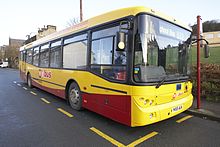| School bus yellow | |
|---|---|
| Hex triplet | #FFD800 |
| sRGBB (r, g, b) | (255, 216, 0) |
| HSV (h, s, v) | (51°, 100%, 100%) |
| CIELChuv (L, C, h) | (87, 99, 69°) |
| Source | [Unsourced] |
| B: Normalized to [0–255] (byte) | |
School bus yellow is a color which was especially formulated for use on School buses in North America in 1939. The color is now officially known in Canada and the U.S. as National School Bus Glossy Yellow and was originally called National School Bus Chrome. The pigment used for this color was, for a long time, the lead-containing chrome yellow.[1]

In April of that year, Dr. Frank W. Cyr, a professor at Teachers College, Columbia University in New York organized a conference that established national school-bus construction standards for the U.S., including the standard color of yellow for the school bus. It became known officially as "National School Bus Chrome." The color was selected because black lettering on that hue was easiest to see in the semi-darkness of early morning.
The conference met for seven days and the attendees created a total of 44 standards, including specifications regarding body length, ceiling height and aisle width. Paint experts from DuPont and Pittsburgh Paints participated. Dr. Cyr's conference, funded by a $5,000 grant from the Rockefeller Foundation, was also a landmark event inasmuch as it included transportation officials from each of the then 48 states, as well as specialists from school-bus manufacturing and paint companies. The color was adopted by the National Bureau of Standards (Now the National Institute of Standards and Technology) as Federal Standard No. 595a, Color 13432.
The conference approach to school bus safety, as well as the yellow color, has endured into the 21st century. Dr. Cyr became well known as the "Father of the Yellow School Bus."
School Bus Yellow outside North America



North American-style yellow school buses (built by European manufacturers) are being introduced in some parts of the United Kingdom, prompted by corporate links to the American industry, for example First Student UK, or a desire to re-brand school buses, such as West Yorkshire Metro's Mybus[2].
Digital representation
| School Bus Yellow | |
|---|---|
| Hex triplet | #FFD800 |
| sRGBB (r, g, b) | (255, 216, 0) |
| HSV (h, s, v) | (51°, 100%, 100%) |
| CIELChuv (L, C, h) | (87, 99, 69°) |
| Source | [Unsourced] |
| B: Normalized to [0–255] (byte) | |
| Tangerine Yellow | |
|---|---|
| Hex triplet | #FFCC00 |
| sRGBB (r, g, b) | (255, 204, 0) |
| HSV (h, s, v) | (48°, 100%, 100%) |
| CIELChuv (L, C, h) | (84, 98, 64°) |
| Source | [Unsourced] |
| B: Normalized to [0–255] (byte) | |
It is not possible to get an accurate representation of school bus yellow on a computer screen because of the way color works. Basically, a surface that does not generate light such as a school bus uses a subtractive color model, while a surface that does generate light such as a computer monitor uses an additive color model, and the differences inherent to these models make it impossible to accurately and reliably convert a color representation from one model to the other. A good estimation of school bus yellow in the RGB color model is rgb(255, 216, 0), or the hex triplet #FFD800. Another reasonably close color is Tangerine Yellow, rgb(255, 204, 0) or #FFCC00, which, although not as close as the previous, carries the advantage of being a web-safe color.
References
- ^ Worobec, Mary Devine (1992). Toxic Substances Controls Guide: Federal Regulation of Chemicals in the Environment. p. 13. ISBN 9780871797520.
((cite book)): Text "BNA Books" ignored (help) - ^ Executive Summary – Mybus report on West Yorkshire Metro website, retrieved 2009-10-09
See also
- School bus (main article)
- Safety orange
- List of colors
A typical sample is shown for each name; a range of color-variations is commonly associated with each color-name. |